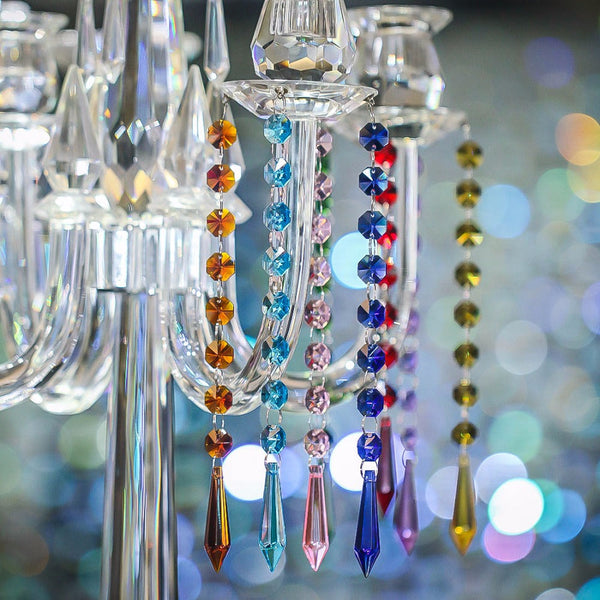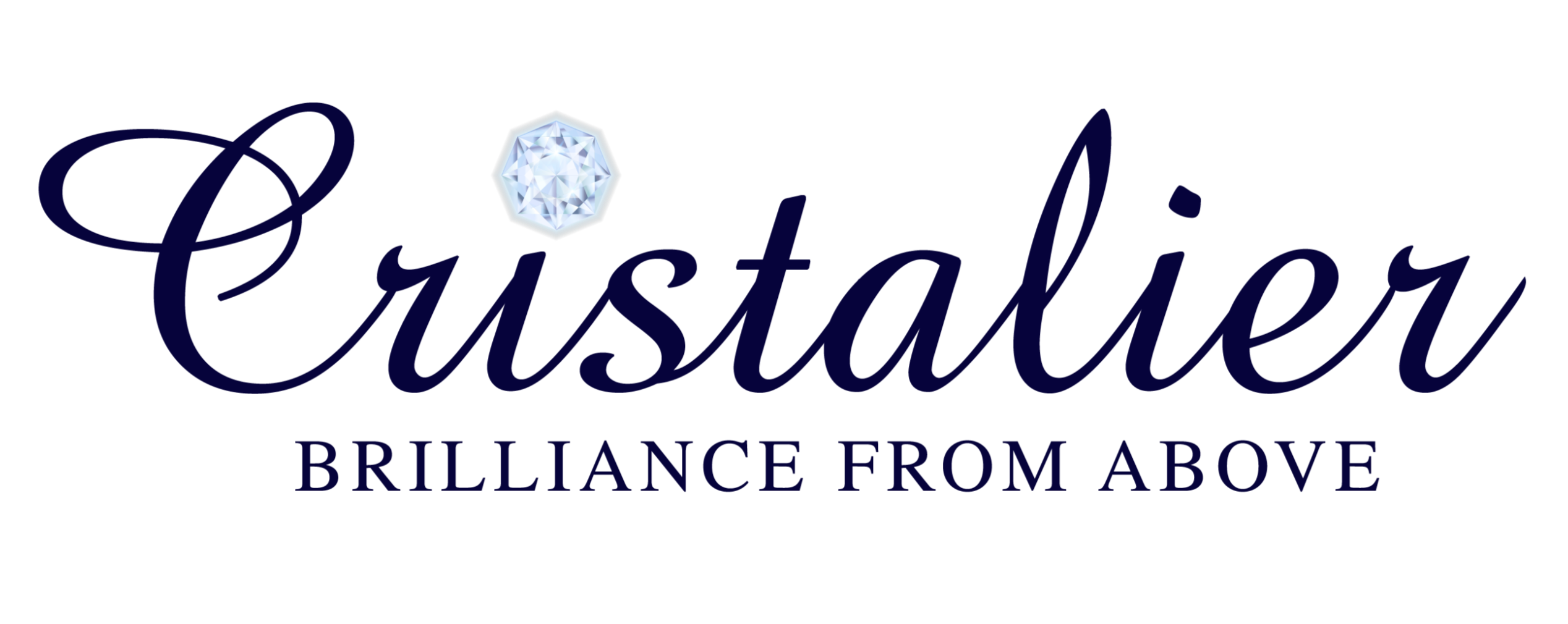

faq
We offer you selection. You finally have the choice to purchase either acrylic, glass or lead crystals at prices below market. While we offer low prices we never sacrifice quality. Many of our competitors use a lower grade of glass to create their crystals. While they may look the same online they aren't. We use the highest grade of glass to manufacture Cristalier crystals.
Washing crystal is best done in a plastic tub with lukewarm soapy water. If you must use a metal sink make sure the faucet is swung out of the way and put a kitchen towel on the bottom of the sink. Using a soft brush in a circular motion will remove all dust and other debris from the cuts. Rinse with clear water and let dry.
Special care should be applied to our leaded crystals as well as our glass crystals. Handled correctly, fine crystals can last a lifetime, here are a few guidelines for caring for fine glasses.
Avoid tapping or knocking the crystals with metal or another glass. This kind of treatment creates small abrasions on the glass which are invisible to the naked eye, but which weaken the surface, making it more susceptible to cracking and chipping.
Crystal is best stored in a dust and smoke free environment. Quick temperature changes should be avoided.
The content of lead (in the form of lead oxide) determines optical properties of glass. High lead content in crystal glass means increased refraction properties of prisms. Perfect cut and polishing further increases refraction.
Lead crystal will not harm you. The only way that the lead in crystal can affect its contents is if you are storing alcohol in lead crystal decanters for an extended period of time. Although there have not been a large number of health issues relating to the lead in crystal, companies and manufacturers do recommend that you only keep alcohol in lead crystal decanters for up to 3 months.
Glass is an organic substance consisting of a mixture of silicates, barates or phosphates that cools to a rigid condition without crystallization. (It can be made of quartz-sand, lime, soda, potash and lead oxide.) Crystal falls into the 3 main categories. Fine Crystal or Crystalline is made from a glass mixture that contains 6% - 10% lead oxide. Lead Crystal is made from a glass mixture that contains 10% - 24% lead oxide and Full Lead Crystal is made from a glass mixture that contains 24% lead oxide or more. For the most part, crystal by European standards regards 24% lead bearing glass as crystal. However, by American standards, any glass that is perfectly clear is considered crystal regardless of the lead content. Lead oxide in crystal gives the product clarity and sparkle. Any crystal that is hand-cut usually must be 24% lead oxide or over - otherwise the crystal would be too brittle and would break when cut or engraved.
Swarovski crystals are amazing and no one in the world has access to their secret formula in regards to creating their crystals. It is speculated that Swarovski crystals contain some 30+ % lead which gives them their fire and sparkle. Swarovski manufacturers under three names...
1. "Swarovski" - which is Jewelery and Crystal figurines only.
Fully leaded (+30% minimum), machine cut and polished on all surfaces. Considered the ultimate in cut, clarity and quality. Used extensively for jewellery, clothing embellishment, and home décor figurines by designers worldwide. In general, colours and quality are very consistent so if budget is not an issue, these will give you the best sparkle money can buy. From time to time a Swarovski Jewelry crystal (ie hearts, snowflakes, crosses, stars) will be offered as a chandelier crystal but please note; there are no actual "Swarovski" chandelier crystal parts available.
2. "Strass" - which is a line of Chandelier Crystals commonly found in the market today and is a FULL LEAD crystal with a small logo etched in each crystal often found near the top hole. This is the highest quality lead crystal available in the world. Many companies will sell this type of crystal chandelier part and label it as "Swarovski" when in truth it is "Strass" crystals. You will find many crystal chandeliers sold have the Strass label.
3. "Spectra" - which is the only line of LEAD FREE chandelier crystals marketed under the Swarovski umbrella. Spectra Crystals are only sold to 4 major chandelier manufacturers in the world (according to the US Swarovski Sales Rep). This line of Lead free crystals are not readily available to the public as loose chandelier pieces although random pieces may surface from time to time. Spectra Prisms have the same high quality cut and surface polishing as all Swarovski products, but are lighter in weight because they have a much lower lead content - not enough to qualify being called Lead Crystal as Strass, these would be known as Lead Free Spectra Crystals.
There is no comparing Swarovski and any other brand of crystals. As technology advances, new crystal qualities are becoming available at lower prices. With Cristalier Glass Crystals your project will still be beautiful, it will only cost you a lot less. If you have an open budget than Swarovski crystals are a definate option, but if you want brilliance while keeping cost in mind, Cristalier crystals are the clear choice!
Cristalier crystals are manufactured in our factory overseas; we also manufacture the majority our own acrylic line of crystals here in the US.
Full-lead crystal means that the glass contains more than 24% of lead-oxide.
Mainly because of the lack of cutting facilities and training. Also, since the end of the "Brilliant Period" (1875-1918) all the cutters in the US have died out. Most of today's crystal is imported from abroad.
Most colored pieces we cut have two layers of glass, which is called "cased glass." The two layers are fused together at the glass factory. When we cut them we cut through the outer layer of colored glass into the clear part of the piece and expose the clear layer, which gives the piece that nice contrast. Cased "cut to clear" glass is much more difficult to make and to cut, also more time consuming, and therefore more expensive. There are different metal oxides used to color glass. For example, real gold is used to create "gold ruby", cobalt for blue, and iron oxide for green, etc.
Not all designs are originals. We have our stock designs, which we have created ourselves. We also create many originals and limited editions.
Some of our most popular patterns are the pendants, the oval design and the teardrops. But there are many other pieces like the faceted acrylic beads, which are very intricate and time consuming to create.
The majority of Cristalier company reside & work in our factory overseas, this allows us to have lower manufacturing costs thus saving you money. The acrylic line that we manufacture is direct and this also saves you money.
Acid polishing has been done for about 125 years. The glass is polished by immersing the cut pieces into hot acid which practically "melts" the rough particles away from the glass and and produces a smooth, shiny finish.
We will always work with our customers to meet their pricing needs. Call one of our sales assistance and specify your needs. Odds are we can meet your budget.
Our crystal is just as fragile as any other glass on the market. With proper care it should last a lifetime or more.
Yes, we have dozens of way for you to decorate and craft with crystals. Call 206.259.9100 and speak to our designers. They will help you to come up with all sorts of new ideas and color combos for your crystals.
Despite the fact that leaded glass crystal is not hazardous to the cutter or user, Cristalier® has recently developed lead-free crystals that make rainbows almost as well as the traditional leaded glass crystals. We believe in coming up with lead-free crystals to eliminate the first step (turning lead into lead oxide) of crystal-making. That way, fewer workers in the world have to use lead, even if they are turning it into a nontoxic lead compound.
The difference between glass and crystal is the lead content. Glass contains little or no lead. In America, however, glass can be considered crystal on two conditions—it must be perfectly clear and may contain as little as trace amounts of lead. Also, glass usually has softer edges than crystal.
The term “full lead crystal” indicates a 24-percent lead content. And very fine quality crystal will contain anywhere from 36 to 70 percent. Higher lead content increases clarity, brilliance and weight. Lead crystal is soft and more susceptible to scratching.
Jade crystal is known for its green tint, which occurs from iron ore in the silica sand used to produce the glass. The color deepens to an emerald shade as the glass thickens. This product is very popular and economical for affordable recognition awards.
This is considered one of the finest types of crystal available and is as flawless and clear as prescription eyeglasses. The process of grinding and polishing crystal creates a piece that contains no distortion and is completely unblemished. Also, optically clear crystal creates rainbow prisms when placed in direct sunlight.
Acrylic is a useful, clear plastic that resembles glass, but has properties that make it superior to glass in many ways.
Another great advantage of acrylic is that it is only half as heavy as glass. This makes working with acrylic much easier. It can also be sawed, whereas glass must be scored.
Adding to this favorable array of properties, a transparency rate of 93% makes acrylic the clearest material known. Very thick glass will have a green tint, while acrylic remains clear.
There are some misconceptions about acrylic, namely that it yellows, turns brittle and cracks over time. Though this might be true of very cheap forms of plastic, it is not so with acrylic. For example, the fighter planes of WWII have acrylic bubble-tops. Airplane windows are also acrylic. If taken care of, acrylic remains new looking regardless of age or exposure to sun. Some people worry that acrylic scratches too easily, but unlike glass, scratches can be easily buffed out of acrylic.


